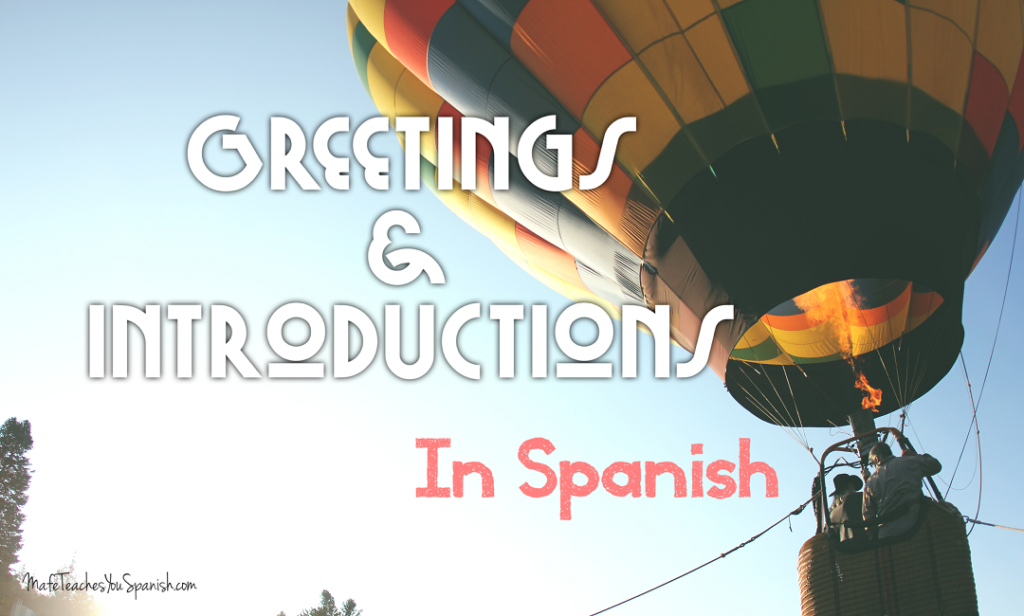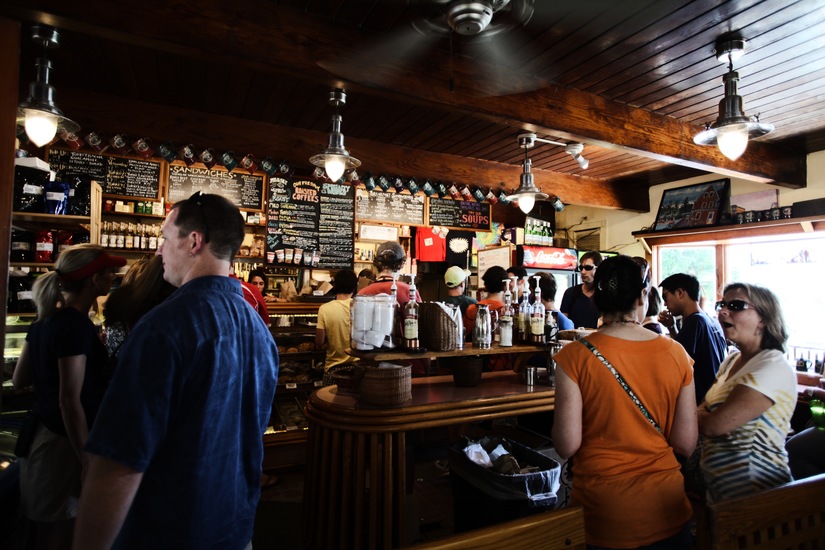HOW TO HAVE SMALL TALK WITH NEW FRIENDS IN SPANISH

The most useful thing to learn in any language is how to meet new people. Practicing your target language is the fastest way to improve it.
Here is how you can greet people, how to introduce yourself and how to have small talk with them.
GREETINGS
!Hola! – Hello, Hey: This is the friendliest way to say hello. You would use it in an informal situation.
Buenos días or Buen día – Good Morning: It is more formal, for example greeting people in the morning at the office or at school.
Buenas tardes – Good afternoon: It is also formal, to be used after noon, until the sun goes down.
Buenas noches –Good evening, Good night: In Spanish it works for both, greetings and farewells in the evening.
¡Buenas! – Hey: It is a very informal way to greet, for example when you walk into a store or a house, or when you join a group of friends or a conversation.

Q: ¿Cómo estás? – How are you?: It is informal and the most common way to ask how someone is. The formal variation would be: ¿cómo está?
A: Estoy bien, gracias ¿y tú? – I´m good thanks, and you?: Positive, informal but polite. Try to use gracias often. The formal variation would be: Estoy bien, gracias ¿y usted?
A: No estoy muy bien – Not so good: If you are having a bad day 🙁
Q: ¿Cómo te va? – How´s it going?: Very common too. The formal variation would be: ¿Cómo le va?
A: Me va bien gracias, ¿y a ti? – It´s going well, thanks and you? The formal variation would be: Me va bien gracias, ¿y a usted?
Q: ¿Cómo te ha ido?– It´s another way to ask how´s it going, or how has it been? The formal variation would be: ¿Cómo le ha ido?
A: Me ha ido muy bien, gracias, ¿y a ti? The formal variation would be: Me ha ido muy bien, gracias, ¿y a usted?
Q: ¿Qué tal? ¿Qué hubo?– Whats up?: Very informal. Remember that the h is silent. ¿Qué hubo? Tends to sound more like quiubo (ki-u-bo)
A: Todo bien, ¿y tú?– it´s all good, and you?: Very informal
FAREWELLS

Chao – Bye: It is very informal, to be used with friends and family
Adiós – Good Bye: A little bit more formal, you would use it with people you are not very close to.
Hasta luego – Until later: It is also formal, to be used in a formal situation like work, school etc.
Nos vemos – See you: Very informal and friendly.
Nos vemos el… – See you on…: When you know when you’ll see the person again, just plug the day you’ll see them. For example: Nos vemos el lunes: See you on Monday or Nos vemos la proxima semana: See you next week.
Hasta el… – Until… : Same thing, when you know when you’ll see them again. For example: Hasta el lunes:Until Monday or Hasta la proxima semana: Until next week. This version tends to be more polite.
¡Cuidate! – Take care!: It is very informal; you would use this with friends. Your mom would say this when you leave the house etc.
Que tengas un buen día. – Have a nice day. Formal version would be: Que tenga un buen dia.
INTRODUCTIONS

There are two common ways to ask for someone’s name, and so there are 2 ways to answer:
Q: ¿Cómo te llamas? – Literally means: How are you called? But it is the equivalent in Spanish to What’s your name?. It is informal, the formal version would be: ¿Cómo se llama?
A: Yo me llamo… – I am called (literally) or My name is…
Q: ¿Cómo es tu nombre? – What’s your name? Informal situation. The formal would be: ¿Cómo es su nombre?
A: Mi nombre es… – My name is…
Mucho gusto – Nice to meet you (formal and informal) The most common reply.
Mucho gusto en conocerle – It is nice to meeting you. Sounds more formal.
Encantado (a) – Pleasure to meet you. Encantado if you are a boy. Encantada if you are a girl.
Q: ¿Cuántos años tienes? – How old are you? Informal. ¿Cuántos años tiene? Formal.
A: Yo tengo… años – I am … years old. We use the verb to have (tener) when we talk about the age instead of the verb to be (ser/estar). In Spanish I have x years, instead of I am x years old.
Q: ¿De dónde eres? – Where are you from? Informal ¿De dónde es usted? Formal.
A: Yo soy de… – I am from
Te presento a… es mi…: Let me introduce you… s/he is my…
Q: ¿Qué haces?, ¿A qué te dedicas?, ¿En que trabajas? – What do you do?, What’s your job? Variations of the same question, when you want to know what they do for a living.
A: Yo soy…– I am … and add your profession
Now, let’s practice how you will give a small introduction about yourself. Follow my example to create yours
Hola, mi nombre es Mafe y soy de Colombia.
Yo tengo 28 años y soy profesora de español.
Me gusta leer y viajar
Hi, my name is Mafe and I am from Colombia.
I am 28 years old and I am a Spanish Teacher.
I like to read and travel
Write in your comments your own introduction and I will review it and correct it for you
SMALL TALK
Let’s look at an example of a conversation you could have right now, using what you have just learned! This is very informal and friendly.

Pepe: Hola, ¿como estas? – Hi, how are you?
Joey: Bien ¿y tú? – Good and you?
Pepe: Bien, gracias, ¿cómo te llamas? – Good, thanks. What’s your name?
Joey: Yo me llamo Joey ¿y tú? – I am Joey and you?
Pepe: Mi nombre es Pepe – My name is Pepe
Joey: Mucho gusto Pepe – Nice to meet you Pepe
Pepe: Encantado – Pleased to meet you (We would keep it that short, just encantado(a) while you shake hands)
Joey: ¿De dónde eres Pepe? – Where are you from Pepe?
Pepe: Yo soy de Bogotá, Colombia ¿y tú? – I am from Bogotá, Colombia and you?
Joey: Yo soy de California – I am from California
Pepe: ¿Cuántos años tienes? – How old are you?
Joey: Yo tengo 25 años, ¿y tú? – I am 25 and you?
Pepe: ¡Yo también! – Me too!
¿Hace cuanto estudias español? – How long have you been studying Spanish?
You can use the expression Hace cuanto …. To ask for how long something has been happening
Joey: He estudiado español por un mes – I have studied Spanish for a month
Pepe: ¿Qué te gusta hacer? – What do you like to do?
Joey: Me gusta viajar – I like to travel
Pepe: Te presento a Andrés, él es mi hermano – Let me introduce you to Andrés, he is my brother.
Andrés: Mucho gusto – Nice to meet you
Joey: Me tengo que ir, nos vemos – I have to go, see you
Pepe: Chao, ¡cuídate! – Bye, take care!
Joey: Chao, ¡que tengas un buen día! – Bye, have a nice day!
Let me know if this was useful to you. Questions? Leave them in the comments.
Don’t worry if you make mistakes in your first attempts. Practice many times until you get it right!
**SEND ME A MESSAGE NOW TO BOOK YOUR LESSON**
Look smart, share the knowledge
Follow closely for updates. Don’t miss out!